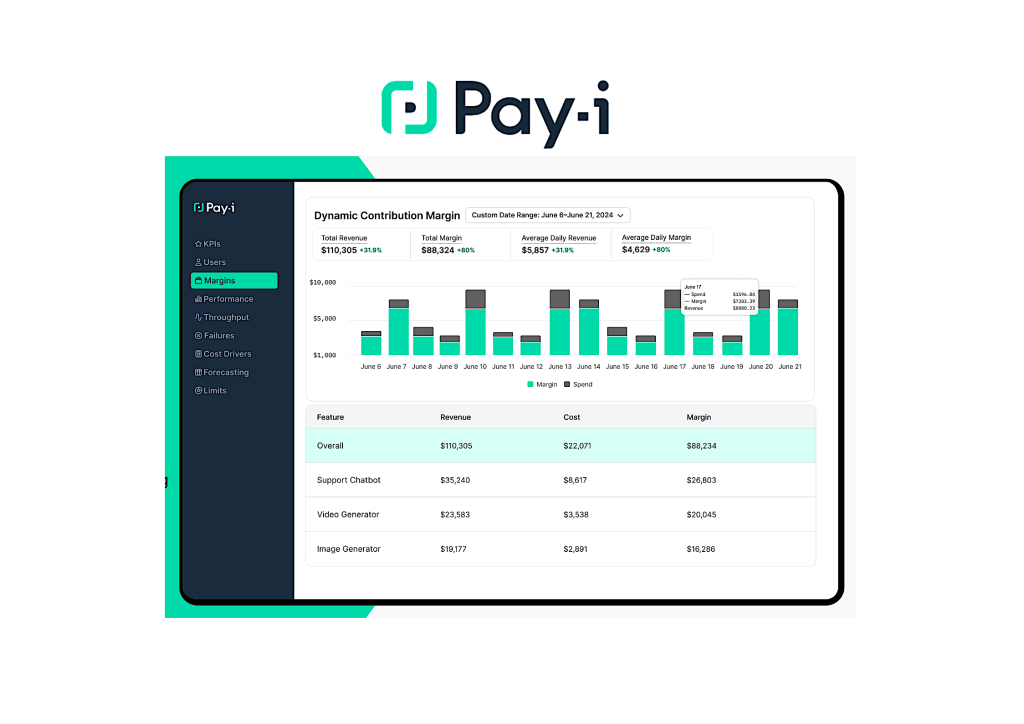
It’s one of those questions that always comes up: what is the ROI on this tool? And the answer is usually very hard to answer, especially in the legal sector. But Pay-i, founded by a team that includes two senior ex-Microsoft execs, seeks to ‘track and forecast genAI returns in real-time’. In particular, the company said they want to push back on the idea that genAI usage alone is a useful metric – and we certainly hear a lot about this metric in the legal world.
And in terms of the cash, the $4.9m Seed round was co-led by Fuse Partners and Tola Capital, with participation from Firestreak, Pear VC, Gaia Capital, and angel investors from Fortune 100 companies.
It seems it’s aimed at companies, for now…., providing things like customer service chatbots and that kind of thing, but one presumes it could be adapted to more complex needs such as legal workflows that are supported by genAI tools, including agentic tools.
This is how they say it works: ‘Pay-i gives a real-time dashboard that links every model call, prompt, and token to measurable business outcomes for specific use cases, like revenue growth, task completion time, or CSAT uplift (i.e. customer satisfaction).
‘Users can assign explicit dollar or time values to KPIs, compare multiple versions of a use case, and instantly see which model, agent, or prompt delivers the strongest return. A built-in forecasting engine then projects those returns forward – so companies can prioritize what works, sunset what doesn’t, and scale GenAI with confidence before it even goes into production.’
Leading the project is CEO David Tepper, who previously spent 19 years at Microsoft and was a leader in Azure’s internal genAI consumption strategy. His first patent on genAI dates back to 2011….!
He has co-founded Pay-i alongside CTO Doron Holan, who spent 27 years at Microsoft and was ‘a core architect for Windows and Azure’s throttling layer’; and COO Erik Winters, a ‘veteran operator who has scaled early-stage companies across finance and SaaS’. So, a team that knows a thing or two about AI and technology…and Windows products – which is where lawyers live (albeit this is not made specifically for lawyers, but for all companies.)
Tepper said: ‘The C-suite doesn’t need another usage chart – they need proof and a forecast. Pay-i pinpoints which genAI use cases create net-new value today, quantifies that value in dollars or hours, and predicts how it will compound tomorrow. Leaders can double-down on winners and reach ROI faster.’
The company stated that this is a product the world needs because ‘IDC projects enterprise genAI investment will top $632 billion by 2028, but 72% of CIOs cite ROI measurement and forecasting as their number 1 blocker’. And that’s one of those pitch lines you can imagine getting buy-in from VCs.
Sheila Gulati, Managing Director at Tola Capital, which is an investor, said: ‘Pay-i turns every AI decision into a clear cost-to-value ratio, letting enterprises see, in real time, how model and design choices affect their metrics. This transparency enables businesses to control their AI spend and allocate resources optimally. Pay-i provides a roadmap for the all-important transition to AI.’
So, is this a big deal?
Could you figure all of this out without a special application like this? Probably, if you put the time in and had the data, but Pay-i looks like it will help speed you to the answers you may want.
But…..the problem with ROI and law firms is…..you guessed it……time vs efficiency. How does X tool increase your profits if you want to sell as much time as possible and X just makes the job go faster? Now, you can see X tool saving you money on the low value bits, so you can do more of the high value stuff (if such work is there in abundance)….but, this time issue really puts a spanner into any logical calculations.
Can this time-barrier be gotten around? You can probably design KPIs around this, but the real answer is to do fixed / scoped fees that allow you to then make clear and logical measurements, without having to make complex back-tracks on your calculations to allow for the fact you actually don’t want to see efficiency get too much into things.
As ever, human ROI and the law works well with humans doing human labour and selling by time on a very human scale. It all gets more complicated when you add tech to the mix that moves in nano-seconds. But, if Pay-i can help, then it’s worth a try.
P.S. for inhouse teams, it’s a different kettle of fish. Time is not your king when inhouse, value is, and if you can get to value faster via tech, then ROI on a tool goes up. And so it goes…..You know the score.
—
Legal Innovators California Conference, San Francisco, June 11 + 12
If you’re interested in the cutting edge of legal AI and innovation – and where we are all heading – then come along to Legal Innovators California, in San Francisco, June 11 and 12, where speakers from the leading law firms, inhouse teams, and tech companies will be sharing their insights and experiences as to what is really happening.
We already have an incredible roster of companies to hear from. This includes: Legora, Harvey, StructureFlow, Ivo, Flatiron Law Group, PointOne, Centari, LexisNexis, eBrevia, Legatics, Knowable, Draftwise, newcode.AI, Riskaway, Aracor, SimpleClosure and more.

See you all there!
More information and tickets here.
Discover more from Artificial Lawyer
Subscribe to get the latest posts sent to your email.

